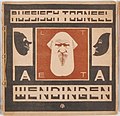Samuel Jessurun de Mesquita
Samuel Jessurun de Mesquita (born June 6, 1868 in Amsterdam , † February 11, 1944 in the Auschwitz concentration camp ) was a Dutch artist.
Life
Samuel Jessurun de Mesquita was born in 1868 as the youngest son of Josua Jessurun de Mesquita and Judith Mendes da Costa. His parents were Portuguese Jews, he had two older siblings (Joseph, born September 7, 1865 and Anna). Samuel Jessurun de Mesquita grew up in Amsterdam.
In 1882, the Amsterdam Rijksakademie van beeldende kunsten (Reich Academy for Fine Arts ) refused to allow him to study. In 1885 he enrolled to study architecture at the Rijksshool voor Kunstnijverheid (technical school for arts and crafts). 1886–1889 he trained as an art teacher at the Rijksnomaalschool.
De Mesquita taught at the Art School in Haarlem and at the Art Academy in Amsterdam. Maurits Cornelis Escher is one of his most important students .
In 1904 he married Elisabeth Pinédo (* March 12, 1874, † February 11, 1944). In 1944 the couple and their son Jaap were deported, the parents presumably murdered on February 11th in Auschwitz , the son on March 30th in the Theresienstadt concentration camp .
MC Escher saved around 450 works by his teacher, which the Nazi thugs had thrown on the street while devastating the studio.
Working for Wendingen
Wendingen was an important architecture and art magazine that appeared from 1918 to 1933. De Mesquita made numerous designsfor the cover .
More work
Jessurun de Mesquita is best known for his woodcuts, especially of animals from the Amsterdam Zoo. But he also made drawings and watercolors, etchings and lithographs, paintings and applied designs.
From 1891, Jessurun de Mesquita regularly exhibits paintings, watercolors, drawings and sketches as part of the Amsterdam Artists' Association. In 1893 he began with etchings, in 1896 with woodcuts.
literature
- Jonieke Van Es: Samuel Jessurun de Mesquita (1868–1944): Tekenaar, graficus, sierkunstenaar. Zwolle (NL): Waanders, 2006. ISBN 978-9040081668 .
- Thomas Hengstenberg (ed.): Samuel Jessurun de Mesquita: From the line to the surface. Bönen: Kettler, 2011. ISBN 978-3-86206-086-3 .
- Jan T. Wilms: Samuel Jessurun de Mesquita. In: Jan T. Wilms (Ed.): Crossing Cultures - The color woodcut in Europe and Japan 1900-1950. Kaufbeuren 2017. ISBN 978-3-9819254-0-1 , pp. 116–119.
- Uta Rosenbaum: Samuel Jessurun de Mesquita - Human Images between Reality and Fantasy , in: Jan T. Wilms (Ed.): Human Images - Ernst Barlach | Otto Dix | George Grosz | Samuel Jessurun de Mesquita - Works on Paper, pp. 88–121, Kaufbeuren 2018. ISBN 978-3-9819254-2-5 .
- Jan T. Wilms: In search of the human image - reflections on the work of Ernst Barlach, Otto Dix, George Grosz and Samuel Jessurun de Mesquita , in: Jan T. Wilms (Ed.): Menschenbilder - Ernst Barlach | Otto Dix | George Grosz | Samuel Jessurun de Mesquita - Works on Paper, pp. 142–186, Kaufbeuren 2018. ISBN 978-3-9819254-2-5 .
Web links
- Information on the Jewish Historical Museum website
- Information on the website of the Gemeentemuseum Den Haag
- Exhibitions at the New York Art Resources Consortium ; Retrieved July 30, 2013
- Announcement of the exhibition of the BC Koekkoek house with pictures of some works by Jessurun de Mesquita; Retrieved September 19, 2014
- Review of an exhibition; Retrieved September 19, 2014
- Short biography ; Retrieved September 19, 2014
Individual evidence
- ↑ Life and work data according to Hengstenberg
- ↑ Brief information on Samuel Jessurun de Mesquita ( Memento of the original from August 12, 2013 in the Internet Archive ) Info: The archive link was inserted automatically and has not yet been checked. Please check the original and archive link according to the instructions and then remove this notice.
- ^ The graphic artist Samuel Jessurun de Mesquita at Cappenberg Castle . Westfälische Allgemeine, April 14, 2011.
| personal data | |
|---|---|
| SURNAME | Jessurun de Mesquita, Samuel |
| BRIEF DESCRIPTION | Dutch artist |
| DATE OF BIRTH | June 6, 1868 |
| PLACE OF BIRTH | Amsterdam |
| DATE OF DEATH | February 11, 1944 |
| Place of death | Auschwitz concentration camp |








